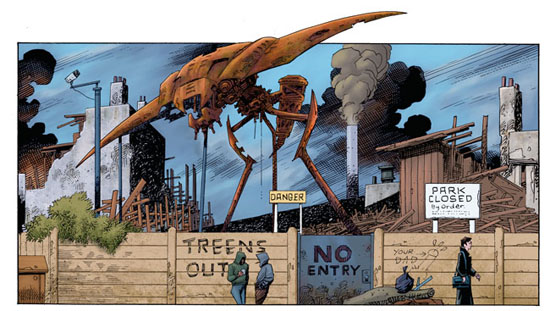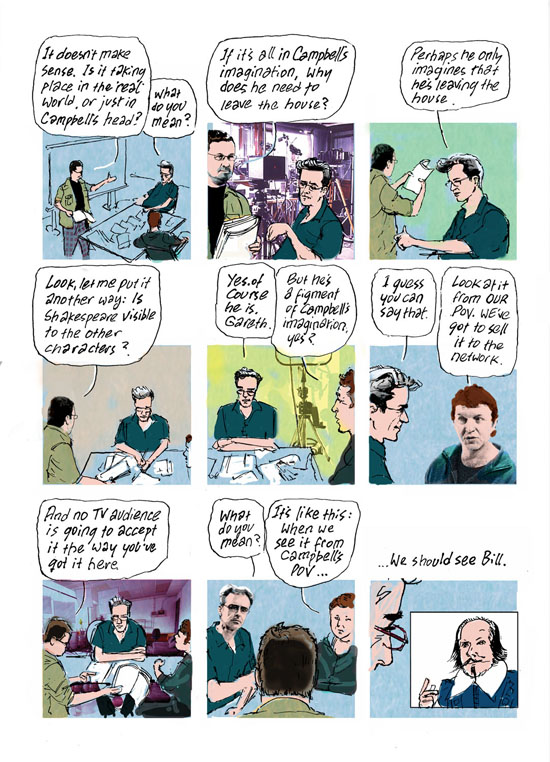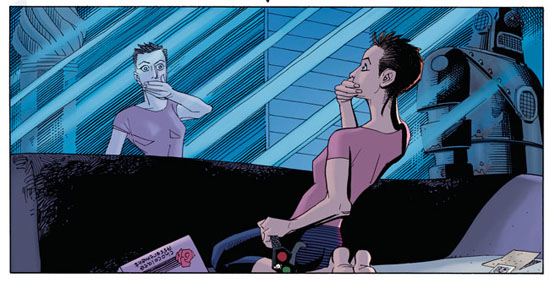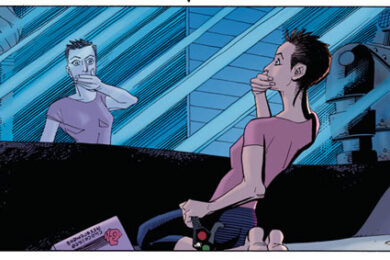So as luck would have it I was looking for a way to start this new, regular column, wondering what the best angle would be, WHEN SUDDENLY (as Stan Lee would put it) the Judge Dredd trailer (sorry DREDD 3D) leaked onto YouTube. Oh, and how it leaked. Leaked like a desultory dribble of piss through an octogenarian’s chinos; like a carton of sour milk at the bottom of a forgotten school satchel; like a coracle barely containing the weight of an unconscious tramp. I’ve given up being angry about it now. The first day or so after watching it I had to be forcibly sedated and locked in a cupboard.
But now, upon release, I find I have reached an acceptance, one that has tipped over into a kind of admiration. Because it must take skill, right? It must take a kind of bum-headed genius to take a source material famed for its clarity of vision, sardonic sense of humour, unique futuristic aesthetic and satirical wit and upon seeing all this laid out before you to go "This should look like an episode of The Shield and be soundtracked by La Roux." I mean that is pretty visionary, right? The same kind of visionary talent that leads you to spread nutella on a piece of plywood and feed it to a child, or to ignore a red light and plough your scooter into a horse drawn cart.
Joking aside, what struck me was, as a friend remarked, "this looks like it was made by people who were ashamed of the source material." I couldn’t have put it better, and that’s one thing that is guaranteed to tick off any comics reader. We’re happy with the changes to the Batman universe that Christopher Nolan made because we understand their necessity; we understand why certain sub-plots were cut out of Akira before it made the screen and why Wolverine has to be a bit taller in the films than he is in the comics. We get this because we know that comics and movies aren’t the same thing and that allowances have to be made in adaptation. What we don’t understand is why, if you want to remake Robocop, you don’t just fucking remake Robocop and leave one of the greatest British comic characters of all time the hell alone.
Of course they haven’t ruined Dredd. There’s a massive industry of reprints and collected editions and his story continues in 2000AD every week, but is it too much to ask to credit an audience with a little imagination? A little nous? An audience that has grown up with over-the-top Hollywood story telling techniques can cope with hover cars, Dark Judges and belly wheels and would think them a lot less upsetting than the sinking feeling of throwing twenty quid at a film that tells the same pointless, dreary cop story again. Gaze into the fist of Dredd, Hollywood! The crime is boredom, the sentence is indifference. Right, with all that out of the way what say we get on with rounding up some interesting recent releases?
The League of Extraordinary Gentlemen – Century: 2009
(Written by Alan Moore. Illustrated by Kevin O’Neill)

So, to take the edge off the horror of the Dredd trailer we start with fellow 2000AD alumnus Alan ‘Watchmen‘ Moore’s century straddling adventurers, The League of Extraordinary Gentlemen. The League are a collection of the fictional heroes of yesteryear (in this case Virginia Woolf’s Orlando, Allan Quartermain and, from Stoker’s Dracula, Mina Harker) assembled to serve England in times of crisis. A sort of meta-fictional Avengers, if you will. Whereas previous instalments of the League were set in the past, allowing its two creators to have what looked like tons of fun referencing every conceivable novel, film or comic from their chosen era, this latest chapter sees The League attempting to prevent the coming of the anti-Christ in 2009, amid a cultural climate that Big Al doesn’t seem to think is a very inspiring one. This lack of belief seems to rub off on the book itself as there’s very little of the joy that came with the earlier volumes (although to be fair League has been moving away from its Boys Own Adventure origins for some time now). The overall tone is muted and dour and isn’t helped by Moore’s none-too-subtle swipes at contemporary mores. "People were desperately poor in 1910 but at least they felt things had a purpose" one character announces "How did culture fall apart in barely a hundred years?", which is as good a way of saying "in-my-day-this-was-all-fields" as any I suppose, but which cuts to the heart of my disappointment with this book. Moore doesn’t appear to be enjoying himself very much.
The effect of this lack of fun is felt on O’Neill’s art as well, which, while beautifully rendered as always, lacks some of the grotesque dynamism of earlier work. One can hardly blame him. I mean it’s got to be a lot more fun drawing an Airship attack over 19th Century London than it is drawing a homeless Martin Clunes, right? However the end result is a bit confusing as the book jumps around in tone from panel to panel. One minute we’re being lectured on the paucity of our culture, the next we’re applauding the creator’s cleverness as we spot characters from the Fast Show hiding in the panel corners and the next being chivvied along by a sadly rather thin plot. The thrill of the chase that defined previous League adventures is replaced by a sense of vague peevishness and wrapped up in an (admittedly very clever) deus ex-machina, leaving an unsatisfied taste in the mouth.
Obviously it’s a Moore and O’Neill book, so there are some absolute delights. A massacre in a certain school for young wizards is brutally and energetically bought to life through flashback, something which comics can do brilliantly and which Moore pretty much defined through his work on Watchmen, and the appearance of Iain Sinclair’s ‘Norton’ character (basically drawn as Sinclair himself) is pitch perfect, but this feels like a missed opportunity. And, Alan, please can you stop having your characters bursting into song half-way through conversations? It really doesn’t work. Cheers.
Prophet #24/25
(Written by Brandon Graham. Illustrated by Farel Dalrymple and Giannis Milonogiannis)
Now that we live in a world without the French comics genius Moebius it’s re-assuring to know that we can seek elegant sci-fi succour in the arms of Brandon Graham’s Prophet. As is if it wasn’t enough that Graham has been pulling in some of the biggest drawing talents in comics over the last few months, Farel Dalrymple and Giannis Milonogiannis being just the latest two examples. He is also turning out the coolest, sexiest sci-fi comic on the racks, a deliberate harking back to the airbrushed brilliance of Heavy Metal magazine in its 80s heyday. Plot-wise, well, I have absolutely no idea what’s going on, but with this kind of sci-fi plot is secondary to feel, and Prophet has feel in abundance. It’s compellingly alien, with the titular character’s motives and reasons shrouded behind the sheer far-future otherness of the setting and this oblique tone is what makes it one of the strangest rides out there at the moment. Look at it this way, I have no idea what a Lone Oniduct Wombship is, how Neonaught Fibres work or how to use a Teuthidan Lance, but being introduced to these things as the story takes shape gives a feel for the universe being constructed better than any amount of purple prose or overt world building. It feels lived in and thought through and it looks beautiful. The best sci-fi book on the racks at the moment by a light year.
Corto Maltese: The Ballad of the Salt Sea
(Written and illustrated by Hugo Pratt)

The Italian cartoonist Hugo Pratt’s Corto Maltese sits squarely in the loveable rogue tradition of fictional sea-captains everywhere (y’know, earring, rolls his own, laughs whenever anyone points a gun at him) and his studied insouciance, plus the fact that these stories were originally published in 1967, had me expecting a pretty typical sea-faring adventure, albeit one enlivened by Pratt’s beautiful artwork. On the face of it that’s what you get, desert island locations, buried treasure and all, but there’s a rich seam of melancholy threaded through this collection that lifts it from being just another caper. The characters pinball between each other, monologuing on their individual neuroses and staring morbidly out to sea, and even the regular bouts of two-fisted action seem isolated and slightly pointless, lost in the expanse of the ocean that surrounds them. The well travelled Pratt’s sense of location is second to none. With just a couple of lines he can conjure an island vista both accurate and impressionistic, so it’s a little disappointing that Universe have chosen to recolour the art. Sure, the palette is muted and evocative, but occasionally the more expressionistic panels (which are the real jewel in the crown of Pratt’s work) are washed out by blocks of unwelcome colour and left difficult to decipher. Having said that, unless you want to go onto Amazon and spend a small fortune on the black and white reprints, this is the only way these stories are available now, so ignore my purist kvetching and pick this handsome edition up.
The Lovely Horrible Stuff
(Written and illustrated by Eddie Campbell )

When a chap is down to his last sheckles it’s easy for him to feel a bit persecuted by an uncaring world, so hearing that Eddie Campbell’s The Lovely Horrible Stuff was a book about money left me with a bit of a sour taste in my mouth. Campbell’s one of the most gifted writer/cartoonists alive, his scratchy line able to take you anywhere he wants you to go, but I was worried I’d be turned off by the subject matter, being one of those blinkered types who can quite happily not think about gas bills for three months before breaking out in boils at the first sight of one.
Campbell’s wry voice wins out though, and the book becomes as much about the emotional side-effects of capitol as it is about economic theory. Taking his customary autobiographical approach, Campbell details the many interconnected ways that money impacts our lives, relationships and the world around us. Telling of how he and his father-in-law’s relationship broke down due to an ill-advised legal vendetta before whisking us off to the Pacific island of Yap to explore its curious heritage of stone currency. His whimsical technique stops the book from ever getting boring (as when William Shakespeare headbutts a TV producer) and the ground covered is extensive, giving this small book a real sense of scale. All this is even more impressive when you consider how Campbell has expanded his palette, utilising photographic backgrounds (which I usually hate) and a much lighter colour scheme than usual, while still retaining his considerable charm. His ability to take facts and figures and render them in a way that feels personal to himself and the reader is second-to-none, and one hopes that this new approach to his material yields further successes. The fact that he’s promised to send me a tenner after he reads this review has obviously not influenced my opinion in the slightest.
Before Watchmen: The Minutemen #1
(Written and illustrated by Darwyn Cooke)
From the stuff we can’t do without to stuff that shouldn’t exist at all. Obviously doing a monthly column means that your actual comic books, the lovely, foldy things that come out every Wednesday, will be a bit difficult to keep current with, but I’ve read the first Before Watchmen and, following giving Uncle Al a light kicking on League earlier, I thought I’d better balance things out. Make no mistake, this comic should not exist. Now, it is a competent comic. Darwyn Cooke, who both writes and draws has a pleasingly retro style which fits neatly with the 1950s world of Rorschach et al’s precursors, The Minutemen.
One sequence, introducing the character of Hooded Justice, is one of the most satisfying crooks-blundering-around-in-a-warehouse-taken-out-by-bloke-in-mask displays I’ve seen in some time, and I see a lot of those. But its pointless attempt to try and stay true to the tone of the original by being slightly ‘edgy’ – y’know, chucking in some racist abuse or having someone wet themselves – means that tonally it’s all over the place, like if the Adam West Batman had suddenly started calling Robin ‘The Boy Wanker’.
Of course, more importantly, the sheer fact that this book exists against Moore’s wishes is a travesty. I don’t think the case is as clear cut as people are saying on either side. Moore has a history of dabbling with other people’s characters (mostly dead people’s, sure) and I find it hard to satisfyingly draw a distinction between his treatment of Wizard of Oz’s Dorothy in Lost Girls and DC Comics treatment of Dr. Manhattan et al. However one fact seems pretty clear, it is a case of a big corporation acting without consideration of ethics or scruples and riding roughshod over the sensitivities and welfare of its employees. These days so much focus is given to asking big companies to behave responsibly. This is no different. Right, that’s that for this month. See you next month for more comics related ribaldry, unless DC decide to mess with Dr Manhattan’s origin story, in which case I imagine I’ll have to be locked in a cupboard again.
MANDROIDS…EXECUTE THE DEATH SENTENCE!!



